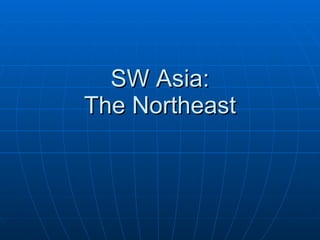SW Asia Regions Peoples Religions Conflicts
•Descargar como PPT, PDF•
2 recomendaciones•900 vistas
The document discusses the geopolitics of Southwest Asia and the Middle East. It covers the ethnic and religious diversity of the region, including the Kurdish people who lack a sovereign state. It also summarizes the Iran-Iraq War from 1980 to 1988, which killed over 1 million people and devastated both countries' economies and infrastructure. Finally, it provides an overview of Iraq's invasion of Kuwait in 1990 and the US-led coalition that drove Iraqi forces out of Kuwait in the Persian Gulf War.
Denunciar
Compartir
Denunciar
Compartir

Más contenido relacionado
La actualidad más candente
La actualidad más candente (20)
Sec4 express chapter1(managing peace & security-iraq&kuwait)lect2

Sec4 express chapter1(managing peace & security-iraq&kuwait)lect2
Destacado
Destacado (14)
Similar a SW Asia Regions Peoples Religions Conflicts
Similar a SW Asia Regions Peoples Religions Conflicts (17)
ISIL is the offspring of WWI, Hitler, Sadam and Poverty

ISIL is the offspring of WWI, Hitler, Sadam and Poverty
Introduction Why We Disagree about International RelationsIn A.docx

Introduction Why We Disagree about International RelationsIn A.docx
Kurdistan the largest nation without country .pptx

Kurdistan the largest nation without country .pptx
Más de Dan Ewert
Más de Dan Ewert (20)
Último
YOUVE GOT EMAIL_FINALS_EL_DORADO_2024.pptx

YOUVE GOT EMAIL_FINALS_EL_DORADO_2024.pptxConquiztadors- the Quiz Society of Sri Venkateswara College
USPS® Forced Meter Migration - How to Know if Your Postage Meter Will Soon be...

USPS® Forced Meter Migration - How to Know if Your Postage Meter Will Soon be...Postal Advocate Inc.
HỌC TỐT TIẾNG ANH 11 THEO CHƯƠNG TRÌNH GLOBAL SUCCESS ĐÁP ÁN CHI TIẾT - CẢ NĂ...

HỌC TỐT TIẾNG ANH 11 THEO CHƯƠNG TRÌNH GLOBAL SUCCESS ĐÁP ÁN CHI TIẾT - CẢ NĂ...Nguyen Thanh Tu Collection
Último (20)
Procuring digital preservation CAN be quick and painless with our new dynamic...

Procuring digital preservation CAN be quick and painless with our new dynamic...
ENGLISH 7_Q4_LESSON 2_ Employing a Variety of Strategies for Effective Interp...

ENGLISH 7_Q4_LESSON 2_ Employing a Variety of Strategies for Effective Interp...
Influencing policy (training slides from Fast Track Impact)

Influencing policy (training slides from Fast Track Impact)
TataKelola dan KamSiber Kecerdasan Buatan v022.pdf

TataKelola dan KamSiber Kecerdasan Buatan v022.pdf
Science 7 Quarter 4 Module 2: Natural Resources.pptx

Science 7 Quarter 4 Module 2: Natural Resources.pptx
MULTIDISCIPLINRY NATURE OF THE ENVIRONMENTAL STUDIES.pptx

MULTIDISCIPLINRY NATURE OF THE ENVIRONMENTAL STUDIES.pptx
USPS® Forced Meter Migration - How to Know if Your Postage Meter Will Soon be...

USPS® Forced Meter Migration - How to Know if Your Postage Meter Will Soon be...
HỌC TỐT TIẾNG ANH 11 THEO CHƯƠNG TRÌNH GLOBAL SUCCESS ĐÁP ÁN CHI TIẾT - CẢ NĂ...

HỌC TỐT TIẾNG ANH 11 THEO CHƯƠNG TRÌNH GLOBAL SUCCESS ĐÁP ÁN CHI TIẾT - CẢ NĂ...
SW Asia Regions Peoples Religions Conflicts
- 1. SW Asia: The Northeast
- 11. Former Secretary of Defense Donald Rumsfeld meeting Saddam Hussein in 1983.